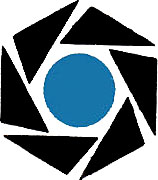
Crocker National Bank was a United States bank headquartered in San Francisco, California. It was acquired by and merged into Wells Fargo Bank in 1986.

Crocker National Bank was a United States bank headquartered in San Francisco, California. It was acquired by and merged into Wells Fargo Bank in 1986.
The bank traces its history to the Woolworth National Bank in San Francisco. Charles Crocker, who was one of The Big Four of the Central Pacific Railroad and who constructed America's first transcontinental railroad, acquired a controlling interest in Woolworth for his son William Henry Crocker. The bank was renamed Crocker Woolworth National Bank, later Crocker National Bank.
In 1925, Crocker National merged with the First National Bank of San Francisco, founded by James D. Phelan, to form Crocker First National Bank. [1]
In 1956, Crocker First National Bank merged with the Anglo California National Bank (established by Herbert Fleishhacker) to form Crocker-Anglo Bank. [1] In 1963, Crocker-Anglo Bank merged with Los Angeles' Citizens National Bank, to become Crocker-Citizens Bank. and later, Crocker Bank.


In the 1970s and early 1980s, Crocker cultivated a reputation for customer service and convenience, including expanded hours. As a part of its promotional campaign, the bank gave various stuffed animals to new customers, including "Sunny", a teddy bear, "Crocker" Spaniel stuffed dogs, and a set of stuffed circus animal “Crockers”. It was also one of the first California banks to offer automated teller machine service. One early television commercial showed a young businessman confidently using the machine, while speaking to it as if it were a person. He was followed by an elderly woman approaching it for the first time, and greeting it with a very uncertain "Hello."
Crocker National Bank was purchased by the British financial institution Midland Bank in 1981, but after a series of financial losses, it was sold to Wells Fargo Bank in 1986. Crocker's executive vice president and two-thirds of the top 70 executives lost their jobs because of the merger. [2]
On April 21, 1975, a Carmichael, California branch of the bank in the Sacramento area was robbed by several members of the Symbionese Liberation Army. SLA member Emily Harris accidentally fired her shotgun (as she later said in a plea deal) and killed Myrna Opsahl, a 42-year-old customer and mother of four. [3] [4] [5]
Scott Adams worked at Crocker during his first years in the business world. He drew on that and other business experience when creating the Dilbert comic strip. [6]
The song "We've Only Just Begun" was originally commissioned by advertising agent Hal Riney for an advertisement for Crocker that ran in early 1970. [7]
Sara Jane Olson is an American far-left activist who was a member of the Symbionese Liberation Army (SLA) in 1975. The group disbanded and she was a fugitive for decades before being arrested. In 2001, she pleaded guilty to attempted murder related to a failed bombing plot. In 2003 she pleaded guilty to second-degree murder related to the death of a customer during a botched bank robbery the SLA committed in California. Known then as Soliah, she was also accused of helping a group hide Patty Hearst, a kidnapped newspaper heiress, in 1974. After being federally indicted in 1976, Soliah was a wanted fugitive for several decades. She lived for periods in Zimbabwe and the U.S. states of Washington and Minnesota.

Scott Raymond Adams is an American author and cartoonist. He is the creator of the Dilbert comic strip, and the author of several nonfiction works of business, commentary, and satire. Adams worked in various clerical roles before he became a full-time cartoonist in 1995. While working at Pacific Bell in 1989, Adams created Dilbert; by the mid-1990s the strip had gained national prominence in America and began to reach a worldwide audience. Dilbert remained popular throughout the following decades, spawning several books written by Adams.

Charles Crocker was an American railroad executive who was one of the founders of the Central Pacific Railroad, which constructed the westernmost portion of the first transcontinental railroad, and took control with partners of the Southern Pacific Railroad.
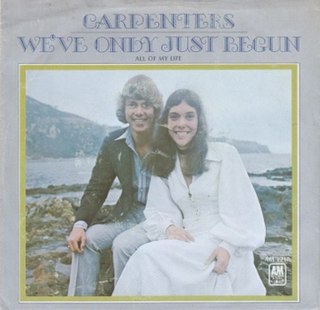
"We've Only Just Begun" is a single by the Carpenters, written by Roger Nichols (music) and Paul Williams (lyrics). It was ranked at No. 414 on Rolling Stone magazine's list of "The 500 Greatest Songs of All Time." It also became Carpenters' second consecutive top-five single in the Billboard Hot 100.

Wendy Masako Yoshimura is an American still life watercolor painter. She was a member of the leftist terrorist group the Symbionese Liberation Army during the mid-1970s. She was born in Manzanar, one of numerous World War II-era internment camps for Japanese Americans who were forced out of their homes and businesses along the West Coast. She was raised both in Japan and California's Central Valley.
The Bank of California was opened in San Francisco, California, on July 4, 1864, by William Chapman Ralston and Darius Ogden Mills. It was the first commercial bank in the Western United States, and considered instrumental in developing the American Old West.

William Henry Crocker I was a member of the wealthy Crocker family and a prominent member of the Republican Party. Over the course of his business career, he became the president of Crocker National Bank.
H.F. Ahmanson & Co. was a California holding company named after Howard F. Ahmanson Sr. It was best known as the parent of Home Savings of America, once one of the largest savings and loan associations in the United States.

Emily Harris was, along with her husband William Harris (1945–), a member of the Symbionese Liberation Army (SLA), an American left-wing terrorist group involved in murder, kidnapping, and bank robberies. In the 1970s, she was convicted of kidnapping Patty Hearst.

Isaias Wolf Hellman was a Kingdom of Bavaria-born American banker and philanthropist, and a founding father of the University of Southern California.

Herbert Fleishhacker, was an American businessman, civic leader and philanthropist. In 1924, he created and helped fund the Fleishhacker Pool in San Francisco, for many years the world's largest outdoor saltwater swimming pool. The pool continued to operate until 1971.
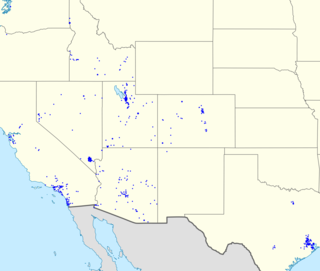
Zions Bancorporation is an American national bank headquartered in Salt Lake City, Utah. It operates as a national bank rather than as a bank holding company and does business under the following seven brands: Zions Bank, Amegy Bank of Texas, California Bank and Trust, National Bank of Arizona, Nevada State Bank, Vectra Bank Colorado, and the Commerce Bank of Washington.

Wells Fargo & Company is an American multinational financial services company with a significant global presence. The company operates in 35 countries and serves over 70 million customers worldwide. It is a systemically important financial institution according to the Financial Stability Board, and is considered one of the "Big Four Banks" in the United States, alongside JPMorgan Chase, Bank of America, and Citigroup.

Wells Fargo Center is a twin tower skyscraper complex in Downtown Los Angeles on Bunker Hill, in Los Angeles, California. It comprises South and North towers, which are joined by a three-story glass atrium.

Lloyd Tevis was a banker and capitalist who served as president of Wells Fargo & Company from 1872 to 1892. He also co-founded the Pacific Coast Oil Company, the progenitor to Chevron Corporation.
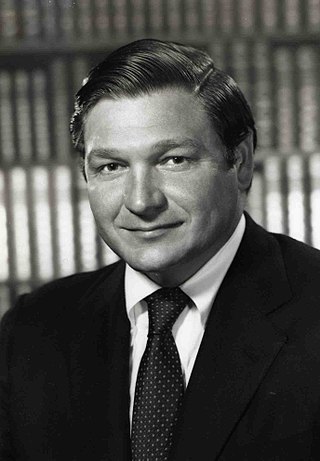
Carl Edwin Reichardt Jr. was an American banking executive and chief executive officer of Wells Fargo Bank.
Abraham Haas was an American businessman, co-founder of the Hellman, Haas & Co., and patriarch of the Haas family.
Lloyds Bank California was a wholly owned subsidiary of Lloyds Bank Plc in the United Kingdom from 1974 to 1986. Throughout its existence, the U.S. retail banking operation functioned as an autonomous unit of the Lloyds Bank Group, alongside Lloyds Bank International and the National Bank of New Zealand.
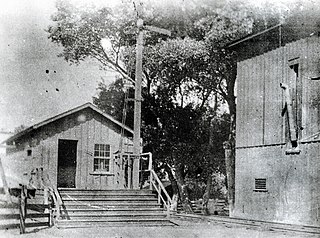
Lang Southern Pacific Station is a former Southern Pacific railway station located in Soledad Canyon near the eastern end of Santa Clarita, California. On September 5, 1876, the first railway to Los Angeles was completed at this site. The Lang Southern Pacific Station was designated a California Historic Landmark on May 22, 1957.
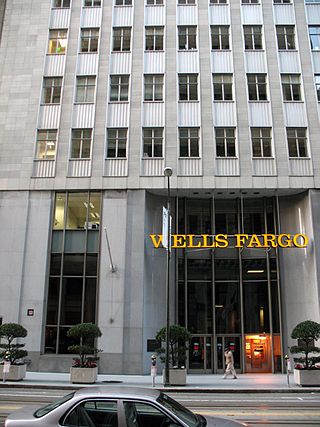
Wells Fargo was an American banking company based in San Francisco, California, that was acquired by Norwest Corporation in 1998. During the California Gold Rush in early 1848 at Sutter's Mill near Coloma, California, financiers and entrepreneurs from all over North America and the world flocked to California, drawn by the promise of huge profits. Vermont native Henry Wells and New Yorker William G. Fargo watched the California economy boom with keen interest. Before either Wells or Fargo could pursue opportunities offered in the Western United States, however, they had business to attend to in the Eastern United States.
{{cite book}}: CS1 maint: location missing publisher (link)